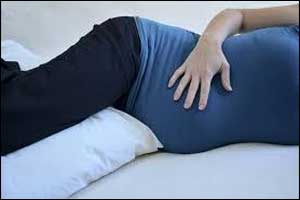- Home
- Editorial
- News
- Practice Guidelines
- Anesthesiology Guidelines
- Cancer Guidelines
- Cardiac Sciences Guidelines
- Critical Care Guidelines
- Dentistry Guidelines
- Dermatology Guidelines
- Diabetes and Endo Guidelines
- Diagnostics Guidelines
- ENT Guidelines
- Featured Practice Guidelines
- Gastroenterology Guidelines
- Geriatrics Guidelines
- Medicine Guidelines
- Nephrology Guidelines
- Neurosciences Guidelines
- Obs and Gynae Guidelines
- Ophthalmology Guidelines
- Orthopaedics Guidelines
- Paediatrics Guidelines
- Psychiatry Guidelines
- Pulmonology Guidelines
- Radiology Guidelines
- Surgery Guidelines
- Urology Guidelines
Lying on one’s side in labour with epidural leads to more spontaneous births

Lying on one’s side in labour with an epidural is safe and leads to more spontaneous births.
Women who lie on their side in the second stage of labour after a low-dose epidural are more likely to give birth spontaneously than those who remain upright when actively contracting. Lying down on either side doesn’t appear to be harmful to mothers or babies. This means that 17 of these women would need to lie on their side instead of maintaining an upright position for one more of them to have an unassisted or “spontaneous” birth.
This UK trial looked at how position in labour affects the type of birth in first-time mothers after a low-dose epidural.
The current guidance recommends an upright position when actively contracting in the later stages of labour. However, this research suggests that for first-time mothers with epidurals, lying on their side could be considered.
Why was this study needed?
Between 2014 and 2015, 16.4% of women who gave birth in England had an epidural during labour.
Epidurals are effective in reducing pain from contractions but may increase the length of the second stage of labour and the likelihood of an assisted birth.
There is low-quality evidence suggesting that giving birth upright could reduce the chances of an assisted birth in women without epidurals. In women with epidurals, very low-quality evidence had pointed to no clear difference between giving birth lying on one’s side and being upright on the chances of having an assisted birth.
This trial aimed to find out whether giving birth upright increased the chances of unassisted spontaneous vaginal birth in first-time mothers with a low-dose epidural, compared with lying on their side.
What did this study do?
This pragmatic randomised controlled trial, BUMPES, involved 3,236 women with a low-dose epidural for labour from 41 UK hospitals.
All were first-time mothers and more than 37 weeks pregnant with a single baby. They were randomly allocated to two groups for the second stage of labour. These were either lying on their side with up to 30 degrees inclination of the bed; or in an upright position (such as walking, sitting out of bed or standing). Midwives encouraged them to stay in their allocated position, but they could change position during labour if they wished.
Participants and midwives knew the birth position allocations, but the main measure, vaginal birth, is objective and unlikely to have been influenced in a major way by previous ideas of benefit. Details of epidural management may have varied between hospitals.
Only first-time mothers with low-dose epidurals took part so the results may not apply to other women including those who have previously given birth.
What did it find?
- Women in the group who gave birth lying on their side were 14% more likely to have a spontaneous vaginal birth; 632 women (41.1%) compared with 548 women (35.2%) in the upright group (adjusted risk ratio [RR] 0.86, 95% confidence interval [CI] 0.78 to 0.94).
- This represents a 5.9% absolute increase in the chance of spontaneous vaginal birth in the lying down group (number needed to treat 17, 95% CI 11 to 40).
- There was no difference between the group of women laying on their side and the upright group on the chances of having an assisted birth, caesarean section or trauma separately.
- There was no statistically significant difference between the group lying on their side and upright group regarding babies’ condition at birth, at five minutes and at a year of age. Only three babies in the lying down group had an Apgar score of less than four at five minutes compared with two in the upright group. The Apgar score measures the baby’s health state one minute and five minutes after birth. Babies are given a score of zero to two for each of the following: heart rate, breathing, colour, muscle tone and response to stimulation. The maximum healthy score is 10.
What does current guidance say on this issue?
NICE 2017 guidance recommends encouraging women to move and adopt whatever positions they find most comfortable throughout labour. This includes women with epidurals.
When actively contracting in the second stage women are told not to lie supine or semi-supine but may adopt any other comfortable position.
What are the implications?
It is vital to involve women in decisions about their pregnancy and labour care. A survey in 2015 found 75% of women in England felt they were always involved in decisions about their labour and birth.
This is an increase from 70% in 2007, but the Care Quality Commission reports that healthcare providers need to do more to ensure women planning a normal vaginal birth can choose the most comfortable birth position.
For first-time mothers who have an epidural in labour, lying down on either side could be considered a safe choice for the birth position.

Disclaimer: This site is primarily intended for healthcare professionals. Any content/information on this website does not replace the advice of medical and/or health professionals and should not be construed as medical/diagnostic advice/endorsement or prescription. Use of this site is subject to our terms of use, privacy policy, advertisement policy. © 2020 Minerva Medical Treatment Pvt Ltd